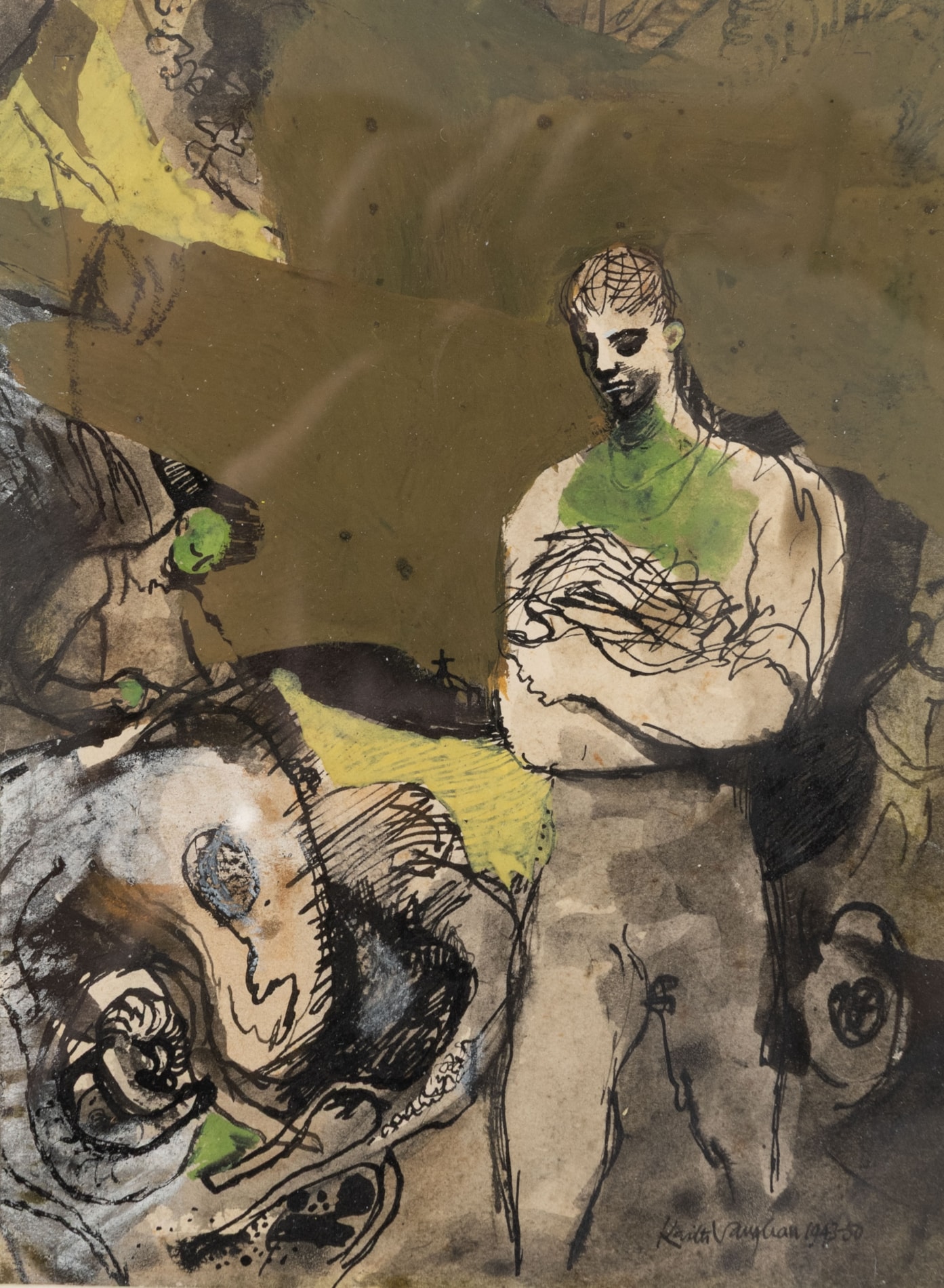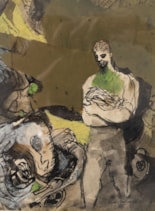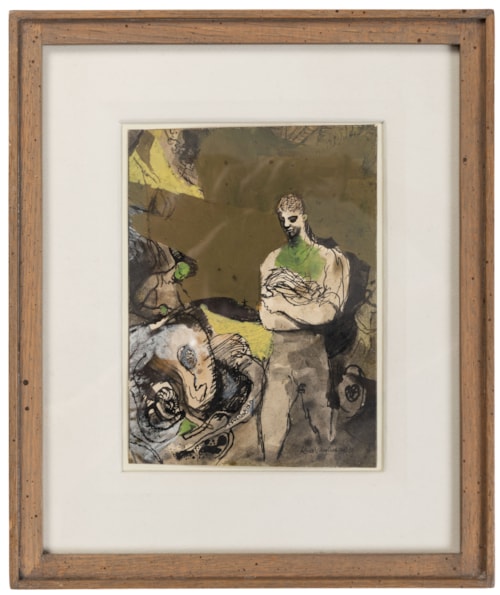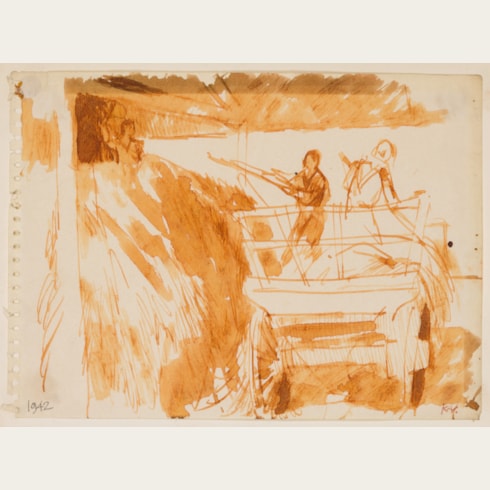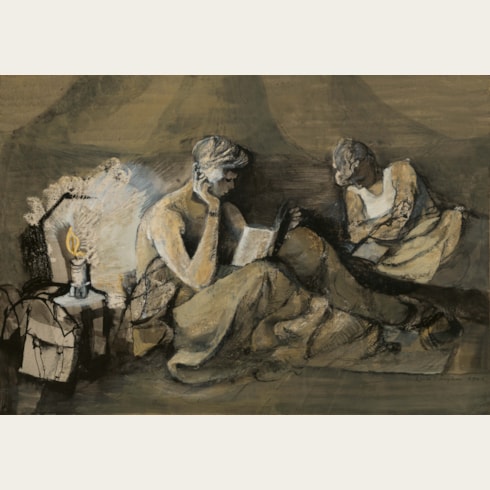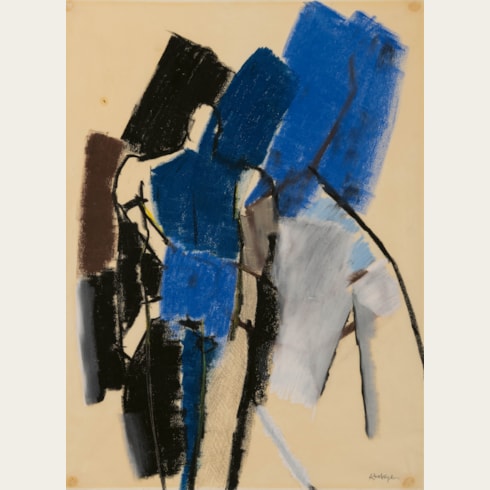Keith VAUGHAN
(Selsey 1912 - London 1977)
Woodman Carrying Faggots
Gouache, black ink and grey wash on paper laid onto board.
Signed and dated Keith Vaughan 1943-50 in black ink at the lower right.
Inscribed Woodman Carrying Faggots / Gouache 7 x 5 / 1943-50 and priced 18-18/- on a label pasted onto the backing board.
186 x 138 mm. (7 3/8 x 5 3/8 in.)
Signed and dated Keith Vaughan 1943-50 in black ink at the lower right.
Inscribed Woodman Carrying Faggots / Gouache 7 x 5 / 1943-50 and priced 18-18/- on a label pasted onto the backing board.
186 x 138 mm. (7 3/8 x 5 3/8 in.)
While serving in the Non-Combatant Corps during the Second World War, and since there was a limited range of media that could be carried in a regulation army knapsack, Keith Vaughan became adept at working in the graphic mediums of Indian ink, pencil, crayon and gouache; the latter usually in dark military colours of green and ochre, which are also often found in his postwar work. While serving in the NCC during the Second World War, and since there was a limited range of media that could be carried in a regulation army knapsack, Vaughan became adept at expressing himself through the graphic mediums of Indian ink, pencil, crayon and gouache; the latter usually in dark military colours of green and ochre.
As he wrote in the foreword to his first gallery exhibition of drawings in 1944, in which several of his army drawings were included, ‘On New Year’s Day 1941, the first thing that went into my brand new army haversack was the largest drawing book it would accommodate and an unbreakable bottle of black ink…I now spent my off-duty hours with a pad on my knee on my bed in a barrack room. For a year I drew the raw material that was in front of me. By 1942 I had done all I wanted of this…To accommodate my slightly increased ambitions, I added to my materials one or two more bottles of ink, two pots of gouache and a few crayons. With these I hoped to be able to recover something of the solidity and depth of oil, while satisfying the requirements of intermittent work and total concealment of the result.’ During the early 1940s Vaughan made numerous drawings of his surroundings, the barracks and fellow soldiers and labourers, some in sketchbooks and some – known as the ‘Army Drawings’ - on much larger paper and typically filled out with gouache. In 1943 the War Artists’ Advisory Committee purchased twelve of Vaughan’s wartime gouaches, a number of which were included in an exhibition of war art organized by Kenneth Clark at the National Gallery.
In the summer of 1942 Vaughan was stationed at a barracks in Codford in Wiltshire, near Ashton Gifford House, where he and his fellow non-combatant soldiers were tasked with clearing the overgrown walled garden and grounds. As he described the garden at Ashton Gifford, in a letter to a friend, ‘The white and ochre branches plunging down into the oceanic surging tangle of nettles. People walking through waist-high grass, through the aqueous leaf-green shadow, arms full of dead wood…And the wall running as an indefatigable horizontal, losing and finding itself in the jungle of weed and ivy…I wanted to capture this in lassoes of line and nets of colour, but it’s more difficult than writing about it.’
A very similar figure carrying a bundle of wood appears in a related gouache and crayon drawing by Vaughan of The Garden at Ashton Gifford, signed and dated 1942, in the Ingram Collection in London. An analogous figure with arms crossed in front of his chest is also found in several variants of a drawing of The Wall at Ashton Gifford.
As he wrote in the foreword to his first gallery exhibition of drawings in 1944, in which several of his army drawings were included, ‘On New Year’s Day 1941, the first thing that went into my brand new army haversack was the largest drawing book it would accommodate and an unbreakable bottle of black ink…I now spent my off-duty hours with a pad on my knee on my bed in a barrack room. For a year I drew the raw material that was in front of me. By 1942 I had done all I wanted of this…To accommodate my slightly increased ambitions, I added to my materials one or two more bottles of ink, two pots of gouache and a few crayons. With these I hoped to be able to recover something of the solidity and depth of oil, while satisfying the requirements of intermittent work and total concealment of the result.’ During the early 1940s Vaughan made numerous drawings of his surroundings, the barracks and fellow soldiers and labourers, some in sketchbooks and some – known as the ‘Army Drawings’ - on much larger paper and typically filled out with gouache. In 1943 the War Artists’ Advisory Committee purchased twelve of Vaughan’s wartime gouaches, a number of which were included in an exhibition of war art organized by Kenneth Clark at the National Gallery.
In the summer of 1942 Vaughan was stationed at a barracks in Codford in Wiltshire, near Ashton Gifford House, where he and his fellow non-combatant soldiers were tasked with clearing the overgrown walled garden and grounds. As he described the garden at Ashton Gifford, in a letter to a friend, ‘The white and ochre branches plunging down into the oceanic surging tangle of nettles. People walking through waist-high grass, through the aqueous leaf-green shadow, arms full of dead wood…And the wall running as an indefatigable horizontal, losing and finding itself in the jungle of weed and ivy…I wanted to capture this in lassoes of line and nets of colour, but it’s more difficult than writing about it.’
A very similar figure carrying a bundle of wood appears in a related gouache and crayon drawing by Vaughan of The Garden at Ashton Gifford, signed and dated 1942, in the Ingram Collection in London. An analogous figure with arms crossed in front of his chest is also found in several variants of a drawing of The Wall at Ashton Gifford.
Born in Sussex, Keith Vaughan moved with his family to North London around the start of the First World War. He showed a gift for the arts from a very young age, earning a Royal Drawing Society certificate at the age of seven, but received almost no formal artistic education and was mostly self-taught. While at boarding school, Vaughan was given special entitlements to study art, since he was the first student to specialize in it, and it was at the Christ’s Hospital school that he mounted his first exhibition of landscapes. At the age of nineteen, Vaughan began work as a trainee in the art department of an advertising firm, where he remained until just before the start of the Second World War. In 1939 he left the firm and moved to the country, intending to paint for a year; this would be the first consistent time Vaughan would spend as a fine artist since his school days. It was also at around this time that he began keeping a written journal, a practice he maintained until his death, and which eventually amounted to some 750,000 words contained in sixty-one volumes.
During the Second World War, Vaughan declared himself a conscientious objector, and was conscripted into the Non-Combatant Corps (NCC), working as a labourer in Wiltshire and Derbyshire. It was during the war that, through the collector Peter Watson, Vaughan came into contact with such contemporaries such as Graham Sutherland and John Minton, both of whom were to be highly influential on the artist’s developing career, as well as John Craxton. It was also during this time that Vaughan began exhibiting his work, first in a group exhibition of War Artists organized by Kenneth Clark at the National Gallery in London in 1943, followed by a small show of drawings – of army subjects, landscapes and figures – at the Alex Reid & Lefevre Gallery in London at the end of the following year.
After the war Vaughan began to work consistently in oil paint. Leaving the army in 1946, he taught part-time at the Camberwell School of Art and held the first exhibition of his paintings and gouaches at the Lefevre Gallery. The same year he moved into a house and studio in Maida Vale that he shared with Minton, working alongside him for the next six years. Vaughan’s postwar style was very different from that of the 1930s, with the artist focussing on oil painting and more fully finished compositions and turning away from the English Neo-Romanticism of his earlier work. He also produced designs for book jackets, magazine illustrations and advertisements, and received an important commission for a fifty-foot-long mural for the Dome of Discovery, a temporary building erected on the South Bank for the 1951 Festival of Britain, which is now lost. Focussing on the nude male form, Vaughan’s work also became more abstract; in 1952 he saw an exhibition of the work of Nicolas De Staël and came away impressed with the French artist’s abstractions. Although today regarded as perhaps the pre-eminent painter of the male nude of the postwar period, Vaughan’s concurrent interest in landscape painting, inspired by his travels around Britain, Ireland, France, Italy, Greece, Spain and Morocco, is such that almost half of his extant paintings are landscapes.
By the first half of the 1950s Vaughan was exhibiting regularly at the Lefevre, Redfern and Leicester Galleries in London, and also at Durlacher gallery in New York. In his later years he taught at the Central School of Art and the Slade School of Art, as well as at Iowa State University in America. The peak of Vaughan’s success came in the 1950s and early 1960s, culminating in a major retrospective exhibition of his work, numbering over three hundred paintings, gouaches and drawings, at the Whitechapel Art Gallery in London in 1962. The exhibition was a critical success, one reviewer commenting that ‘One remains in no doubt, within five minutes of entering the retrospective exhibition of paintings and drawings by Keith Vaughan, that one is in the presence of a very considerable artist and a very consistent one.’ Not long after this, however, the artist began to fear that his works were being overshadowed by newer movements in art, notably British Pop Art and Abstract Expressionism, though he continued to have regular exhibitions in galleries in Britain and America, notably at the Waddington Galleries in London. His health began to worsen and he underwent a series of major operations that sapped him of his energy and exacerbated a tendency to depression. On the morning of 4 November 1977, suffering from terminal cancer, Vaughan committed suicide with a fatal overdose of pills, writing in his journal to the very end.
During the Second World War, Vaughan declared himself a conscientious objector, and was conscripted into the Non-Combatant Corps (NCC), working as a labourer in Wiltshire and Derbyshire. It was during the war that, through the collector Peter Watson, Vaughan came into contact with such contemporaries such as Graham Sutherland and John Minton, both of whom were to be highly influential on the artist’s developing career, as well as John Craxton. It was also during this time that Vaughan began exhibiting his work, first in a group exhibition of War Artists organized by Kenneth Clark at the National Gallery in London in 1943, followed by a small show of drawings – of army subjects, landscapes and figures – at the Alex Reid & Lefevre Gallery in London at the end of the following year.
After the war Vaughan began to work consistently in oil paint. Leaving the army in 1946, he taught part-time at the Camberwell School of Art and held the first exhibition of his paintings and gouaches at the Lefevre Gallery. The same year he moved into a house and studio in Maida Vale that he shared with Minton, working alongside him for the next six years. Vaughan’s postwar style was very different from that of the 1930s, with the artist focussing on oil painting and more fully finished compositions and turning away from the English Neo-Romanticism of his earlier work. He also produced designs for book jackets, magazine illustrations and advertisements, and received an important commission for a fifty-foot-long mural for the Dome of Discovery, a temporary building erected on the South Bank for the 1951 Festival of Britain, which is now lost. Focussing on the nude male form, Vaughan’s work also became more abstract; in 1952 he saw an exhibition of the work of Nicolas De Staël and came away impressed with the French artist’s abstractions. Although today regarded as perhaps the pre-eminent painter of the male nude of the postwar period, Vaughan’s concurrent interest in landscape painting, inspired by his travels around Britain, Ireland, France, Italy, Greece, Spain and Morocco, is such that almost half of his extant paintings are landscapes.
By the first half of the 1950s Vaughan was exhibiting regularly at the Lefevre, Redfern and Leicester Galleries in London, and also at Durlacher gallery in New York. In his later years he taught at the Central School of Art and the Slade School of Art, as well as at Iowa State University in America. The peak of Vaughan’s success came in the 1950s and early 1960s, culminating in a major retrospective exhibition of his work, numbering over three hundred paintings, gouaches and drawings, at the Whitechapel Art Gallery in London in 1962. The exhibition was a critical success, one reviewer commenting that ‘One remains in no doubt, within five minutes of entering the retrospective exhibition of paintings and drawings by Keith Vaughan, that one is in the presence of a very considerable artist and a very consistent one.’ Not long after this, however, the artist began to fear that his works were being overshadowed by newer movements in art, notably British Pop Art and Abstract Expressionism, though he continued to have regular exhibitions in galleries in Britain and America, notably at the Waddington Galleries in London. His health began to worsen and he underwent a series of major operations that sapped him of his energy and exacerbated a tendency to depression. On the morning of 4 November 1977, suffering from terminal cancer, Vaughan committed suicide with a fatal overdose of pills, writing in his journal to the very end.
Provenance
James Grady, Atlanta, Georgia
Private collection
Anonymous sale, London, Christie’s, 22 May 1996, lot 4
Anonymous sale, London, Christie’s South Kensington, 14 November 1997, lot 296
Private collection, London.
Private collection
Anonymous sale, London, Christie’s, 22 May 1996, lot 4
Anonymous sale, London, Christie’s South Kensington, 14 November 1997, lot 296
Private collection, London.

